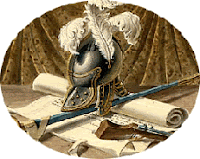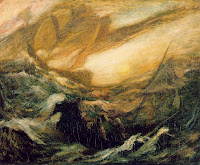
The
Oxford Compantion to Ships and the Sea mentions that the theme of the Flying Dutchman has been used in various literary forms, the best known being Marryat's book
The Phantom Ship, Scott in his poem
Rokeby, and Wagner's opera
Der fliegende Holländer.Rokeby? I'd never heard of it!
Luckily the Edinburgh University Library has a
fantastic site on Rokeby as part of its
Walter Scott Digital Archive with links to electronic texts. For
Rokeby, we're sent to
The Making of America digital text archive, which offers text navigation that should, in my opinion, set the standard for how electronic text navigation should work. Like
Project Gutenberg, you can browse as well as search, but with MOA, when you locate a text, there's a bar along the top where you can easily change the format of the viewed page (image, pdf, or text--which allows easy copying & pasting), select different pages, or search within the text. When I searched within Rokeby, I came across:
Then,'mid the war of sea and sky,
Top and top-gallant hoisted high,
Full spread and crowded every sail,
The Demon Frigate braves the gale;
And well the doom'd spectators know
The harbinger of wreck and woe.
I liked this so much I went on to read the opening of the poem:
The Moon is in her summer glow,
But hoarse and high the breezes blow,
And, racking o'er her face, the cloud
Varies the tincture of her shroud;
Wow. A shroud-clad, a dead, moon, with the cloud flying before her on a high wind. I'm hooked. I'll be reading more.
Lastly, don't miss the
Walter Scott Digital Archive Image Collection--it led me to
Jokeby, a Burlesque on Rokeby (which is available in Google Books supposedly in its entirety--unfortunately, not all the pages were scanned completely and some text is missing.)
 Looking for yet more good Halloween reading? In the mood for the supernatural? Like pirates better than phantom ships? How about a book that has both: Tim Powers' On Stranger Tides.
Looking for yet more good Halloween reading? In the mood for the supernatural? Like pirates better than phantom ships? How about a book that has both: Tim Powers' On Stranger Tides. 








